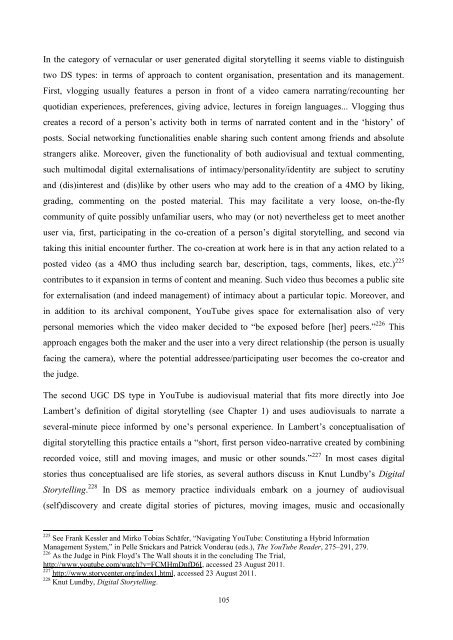UNIVERSITY OF NOVA GORICA GRADUATE SCHOOL ...
UNIVERSITY OF NOVA GORICA GRADUATE SCHOOL ...
UNIVERSITY OF NOVA GORICA GRADUATE SCHOOL ...
Create successful ePaper yourself
Turn your PDF publications into a flip-book with our unique Google optimized e-Paper software.
In the category of vernacular or user generated digital storytelling it seems viable to distinguish<br />
two DS types: in terms of approach to content organisation, presentation and its management.<br />
First, vlogging usually features a person in front of a video camera narrating/recounting her<br />
quotidian experiences, preferences, giving advice, lectures in foreign languages... Vlogging thus<br />
creates a record of a person‘s activity both in terms of narrated content and in the ‗history‘ of<br />
posts. Social networking functionalities enable sharing such content among friends and absolute<br />
strangers alike. Moreover, given the functionality of both audiovisual and textual commenting,<br />
such multimodal digital externalisations of intimacy/personality/identity are subject to scrutiny<br />
and (dis)interest and (dis)like by other users who may add to the creation of a 4MO by liking,<br />
grading, commenting on the posted material. This may facilitate a very loose, on-the-fly<br />
community of quite possibly unfamiliar users, who may (or not) nevertheless get to meet another<br />
user via, first, participating in the co-creation of a person‘s digital storytelling, and second via<br />
taking this initial encounter further. The co-creation at work here is in that any action related to a<br />
posted video (as a 4MO thus including search bar, description, tags, comments, likes, etc.) 225<br />
contributes to it expansion in terms of content and meaning. Such video thus becomes a public site<br />
for externalisation (and indeed management) of intimacy about a particular topic. Moreover, and<br />
in addition to its archival component, YouTube gives space for externalisation also of very<br />
personal memories which the video maker decided to ―be exposed before [her] peers.‖ 226 This<br />
approach engages both the maker and the user into a very direct relationship (the person is usually<br />
facing the camera), where the potential addressee/participating user becomes the co-creator and<br />
the judge.<br />
The second UGC DS type in YouTube is audiovisual material that fits more directly into Joe<br />
Lambert‘s definition of digital storytelling (see Chapter 1) and uses audiovisuals to narrate a<br />
several-minute piece informed by one‘s personal experience. In Lambert‘s conceptualisation of<br />
digital storytelling this practice entails a ―short, first person video-narrative created by combining<br />
recorded voice, still and moving images, and music or other sounds.‖ 227 In most cases digital<br />
stories thus conceptualised are life stories, as several authors discuss in Knut Lundby‘s Digital<br />
Storytelling. 228 In DS as memory practice individuals embark on a journey of audiovisual<br />
(self)discovery and create digital stories of pictures, moving images, music and occasionally<br />
225 See Frank Kessler and Mirko Tobias Schäfer, ―Navigating YouTube: Constituting a Hybrid Information<br />
Management System,‖ in Pelle Snickars and Patrick Vonderau (eds.), The YouTube Reader, 275–291, 279.<br />
226 As the Judge in Pink Floyd‘s The Wall shouts it in the concluding The Trial,<br />
http://www.youtube.com/watch?v=FCMHmDnfD6I, accessed 23 August 2011.<br />
227 http://www.storycenter.org/index1.html, accessed 23 August 2011.<br />
228 Knut Lundby, Digital Storytelling.<br />
105

















